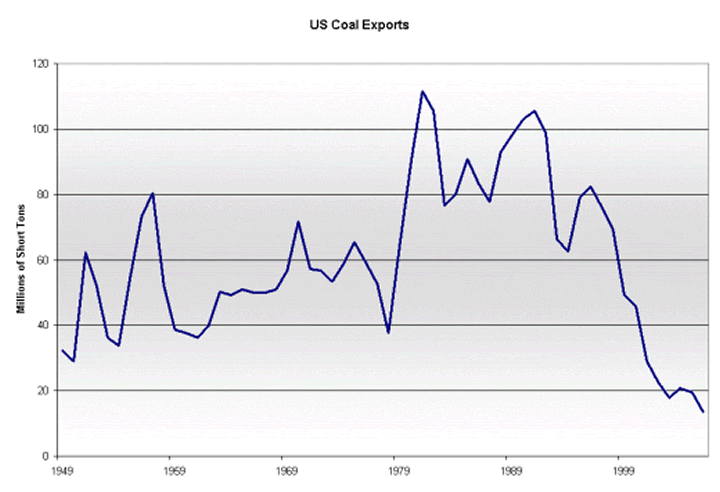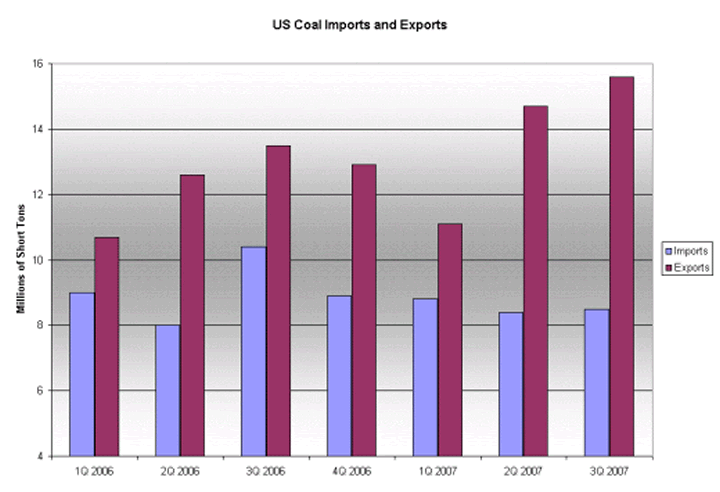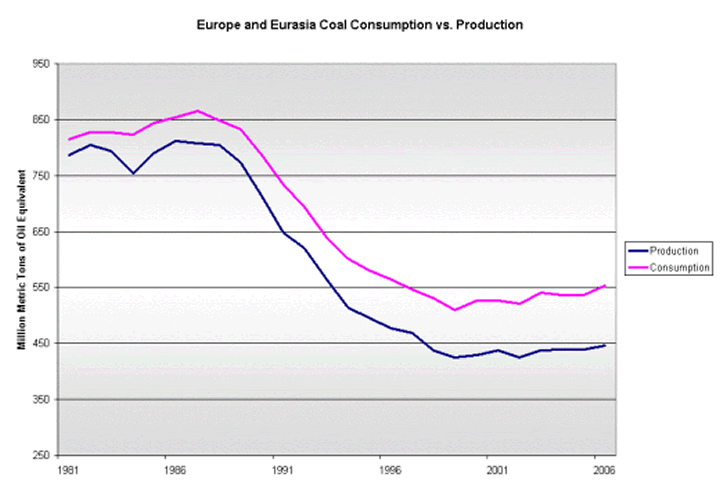COAL The Next Energy Resource Boom
Commodities / Coal Nov 18, 2007 - 09:24 PM GMTBy: Elliot_H_Gue
 The US is often called the Saudi Arabia of coal. And there's a good reason for that: The nation has more than 27 percent of the world's known coal reserves and some of the highest-quality deposits in the world. That's 90 billion metric tons more than Russia, the nation with the second-largest reserves.
The US is often called the Saudi Arabia of coal. And there's a good reason for that: The nation has more than 27 percent of the world's known coal reserves and some of the highest-quality deposits in the world. That's 90 billion metric tons more than Russia, the nation with the second-largest reserves.
With a resource so vast, it may come as a surprise that the US isn't a major player in the global coal trade. After all, the nation ranks only seventh in terms of coal exports, exporting less than 20 percent as much as Australia, the world's largest coal exporter. In fact, US coal exports have been declining steadily since the late 1980s. (See the chart “US Coal Exports.”)
 |
|
Source: EIA
This chart shows total US net exports going back to 1949. Although the US was an important player in international coal trade in the '80s, exports have declined steadily since the end of that decade, hitting an all-time low in 2006.
But that's all old news, and the trend's now clearly shifting. Check out a shorter-term look at US coal exports in the chart below.

Source: EIA
This chart shows US coal imports and exports going back to the first quarter of 2006. There are two obvious trends.
First, coal imports are largely falling, even as there's a significant surge in export volume. For the first three quarters of last year, net exports for the US totaled 9.4 million short tons. In the first three quarters this year, that number jumped by nearly 70 percent to 15.7 million short tons.
And early signs are that the export surge has continued and even accelerated into the fourth quarter. It's likely the US will export more coal this year than it has in any year since the early '90s.
Second, if you're wondering where all that coal is headed, you may find the answer surprising: Forty-four percent of US exports this year went to Europe. Most investors seem to believe that coal-fired power plants are nonexistent in the EU, but that's just not the case. The EU is still a giant consumer of coal.
Check out the chart “Europe and Eurasia Coal Consumption vs. Production” for a closer look.

Source: BP Statistical Review of World Energy 2007
EU coal consumption dropped precipitously between the late '80s and early '90s as coal-fired power plant capacity has been replaced largely with natural gas. But since the late '90s, consumption has actually ticked higher, as has demand for imports.
The common misperception remains that the EU is replacing conventional power plants with renewable energy technologies such as wind and solar. That's just not the case; in fact, whenever you hear talk of the rapid growth in wind and solar power in the EU, you should be thinking about investing more in coal and natural gas. Paradoxically, growth in renewable power capacity spells more demand for conventional power plants.
And that's not just me talking. Consider the following quote from a 2004 report on Germany's wind industry by E.On Netz , the German transmission grid operator:
In concrete terms this means that in 2020, with a forecast wind power capacity of over 48,000 Megawatts [MW], 2,000 MW of traditional power plant capacity can be replaced by these wind farms . . the increased use of wind power in Germany has resulted in uncontrollable fluctuations occurring on the generation side due to the random character of wind power feed-in.
That means that in 2020, after 30 years of heavy subsidy and the expenditure of hundreds of billions of dollars, Germany's wind power plants will replace 2,000 MW of traditional capacity, an amount equal to roughly one large coal-fired plant.
The bottom line: Europe still uses and will continue to use coal for many years. And because production isn't high enough to satisfy local demand, the EU will need to import that coal.
But here's where the story gets even more interesting. It's been getting harder for Europe to source the coal it needs. The problem is that, traditionally, the EU has been able to import seaborne coal sourced from countries such as Australia or South Africa.
The problem is that there's a new player in the global coal trade: developing Asia. This year, for the first time in its history, China became a net importer of coal. This is a change of epic proportions; consider that just three years ago China was exporting more than 80 million metric tons of thermal coal.
As recently as 2002, Japan was importing more than 20 percent of its thermal coal requirements directly from China, and South Korea was another big importer. And don't forget India. The nation will need to import more than 30 million metric tons of coal next year. The result of this shift: Ships are waiting in Australia's ports for as long as a month to pick up shipments of coal because of unprecedented congestion. And the cost of hiring a dry bulk ship to carry coal has doubled since midyear alone.
With so many shipments of seaborne coal being diverted to Asia, Europe is getting squeezed. Their likely solution: Import more coal from the US. After all, coal prices are far lower in the US than in Europe, and the weak dollar makes it even more cost-effective to import US coal.
Consider that a metric ton of coal in Europe costs more than $130; the same coal costs around $50 in the US. Even factoring in $50 in transport costs, the potential profit margins are huge. Even better, the nation is perhaps the only in the world to have actual spare capacity to export at this time.
This is exactly the phenomenon that's started to show up in US export statistics. And based on management comments during the third quarter earnings season, the trend is just getting more entrenched. Consider that the CEO of one of the largest US coal-mining firms stated that European buyers had approached him about signing long-term coal supply contracts.
He went on to say that this is the first time in more than 10 years that European buyers have expressed interest in signing long-term coal supply deals with US producers. Until recently, coal exports to Europe were typically just one-off supply deals. But these customers are now clearly concerned about their coal supplies and are looking for ways to guarantee that their needs will be covered.
I expect we'll hear about a long-term deal in the next quarter or so. And there's also talk of the potential for long-term coal supply deals with Asia. Coal from the vast Powder River Basin (PRB) could be exported to Asia via West Coast ports.
This burgeoning export demand will give rise to some powerful investment themes in the coming year. I see three key ways to play the trend. First, this represents a major new source of demand for US-based coal mining firms. I see that as bullish for coal prices; companies with access to low-cost mines will benefit the most.
On the transport front, most coal in the US is moved by rail. Most investors are pre-programmed to believe that all transport companies are sells when the economy slows down. And we've all heard the perma-bears harp on the sorry performance of the Dow Jones Transportation Index in recent months.
But that's not exactly the whole story. The transport index has been hit mainly because of the poor performance of the airlines and trucking stocks. Both groups are heavily exposed to rising fuel costs and a consumer slowdown in the US.
But the rails are actually performing very well, considering that the Dow Jones Rail Index is up 20 percent this year compared to a 2.3 percent decline for the Dow Jones Truck Index and nearly 22 percent for the airlines. In fourth quarter earnings calls, the rails reported weakness in consumer-oriented businesses, but that was more than offset by strength in coal shipments.
Finally, as I mentioned above, the rates for shipping coal by sea are surging. There's an acute shortage of dry bulk ships to handle this trade. Companies that own such ships are on fire. Even better, most offer highly attractive yields.
By Elliott H. Gue
The Energy Letter
© 2007 Elliott H. Gue
Elliott H. Gue is editor of The Energy Letter , a bi-weekly e-letter as well as editor of The Energy Strategist , a premium bi-weekly newsletter on the energy markets. Mr. Gue is also associate editor for Personal Finance , where he contributes his knowledge of the energy markets.
Mr. Gue has a Master's of Finance degree from the University of London and a Bachelor of Science degree in Economics and Management from the University of London , graduating in the top 3 percent of his class. Mr. Gue was the first American student to ever complete a full degree at that university.
Elliott H. Gue Archive |
© 2005-2022 http://www.MarketOracle.co.uk - The Market Oracle is a FREE Daily Financial Markets Analysis & Forecasting online publication.



